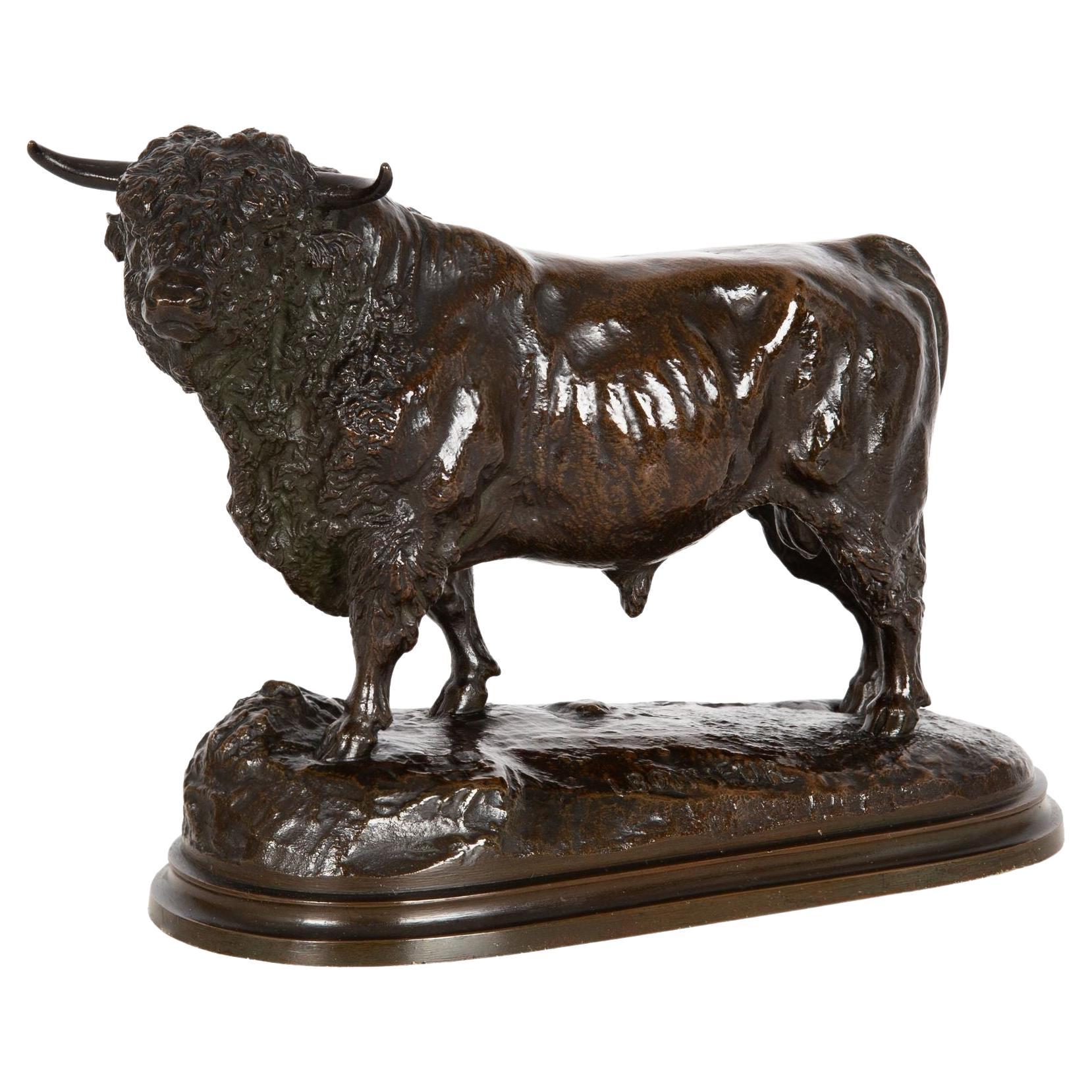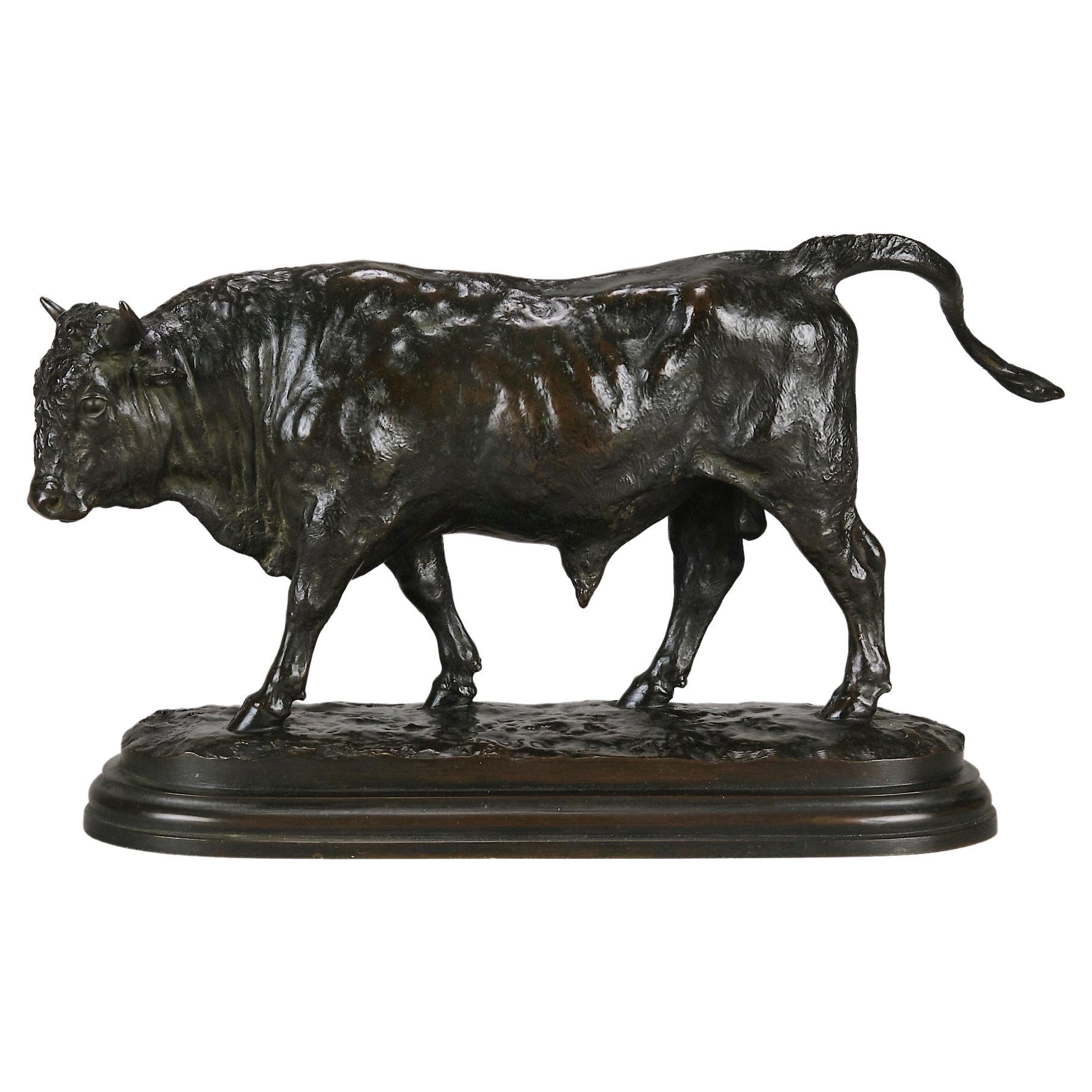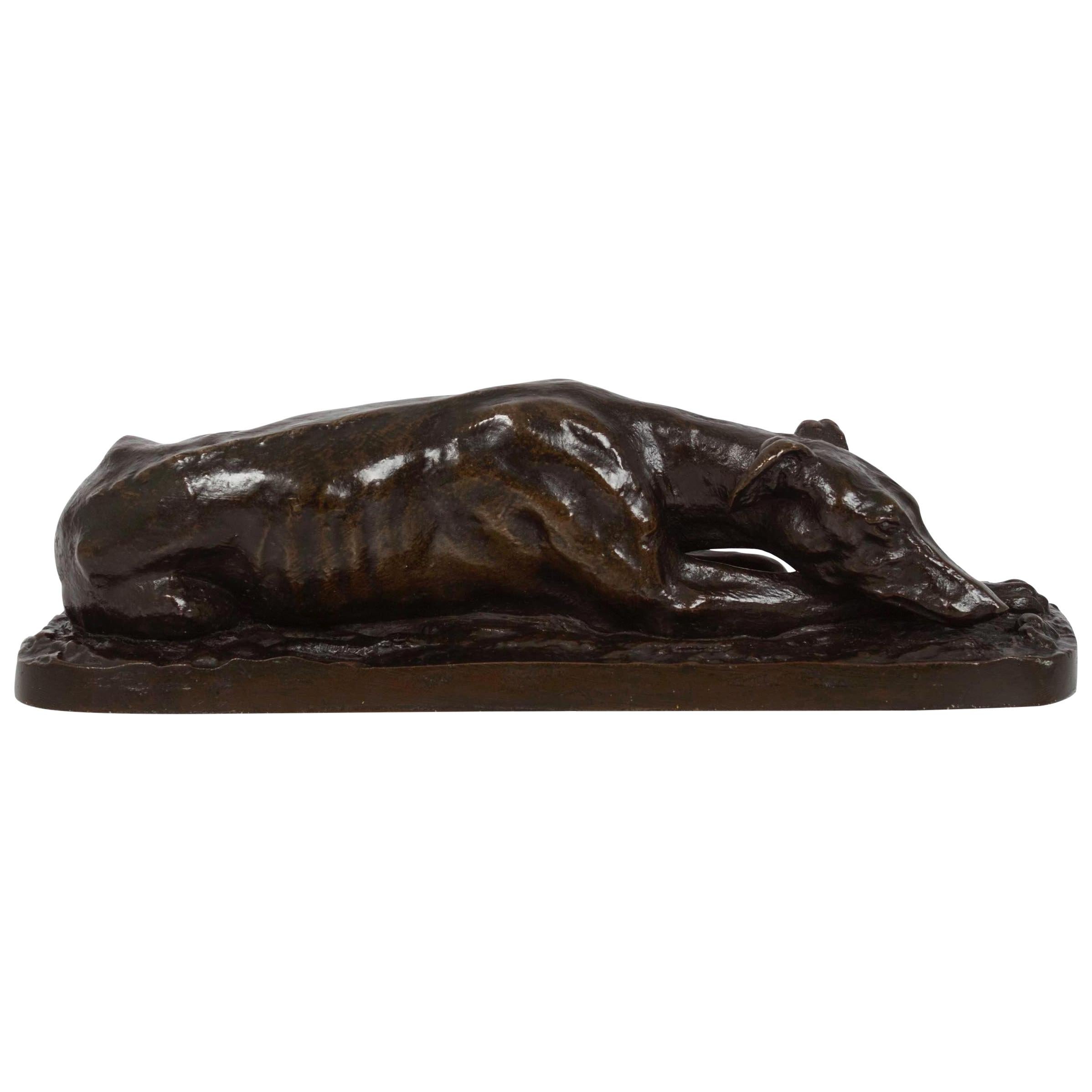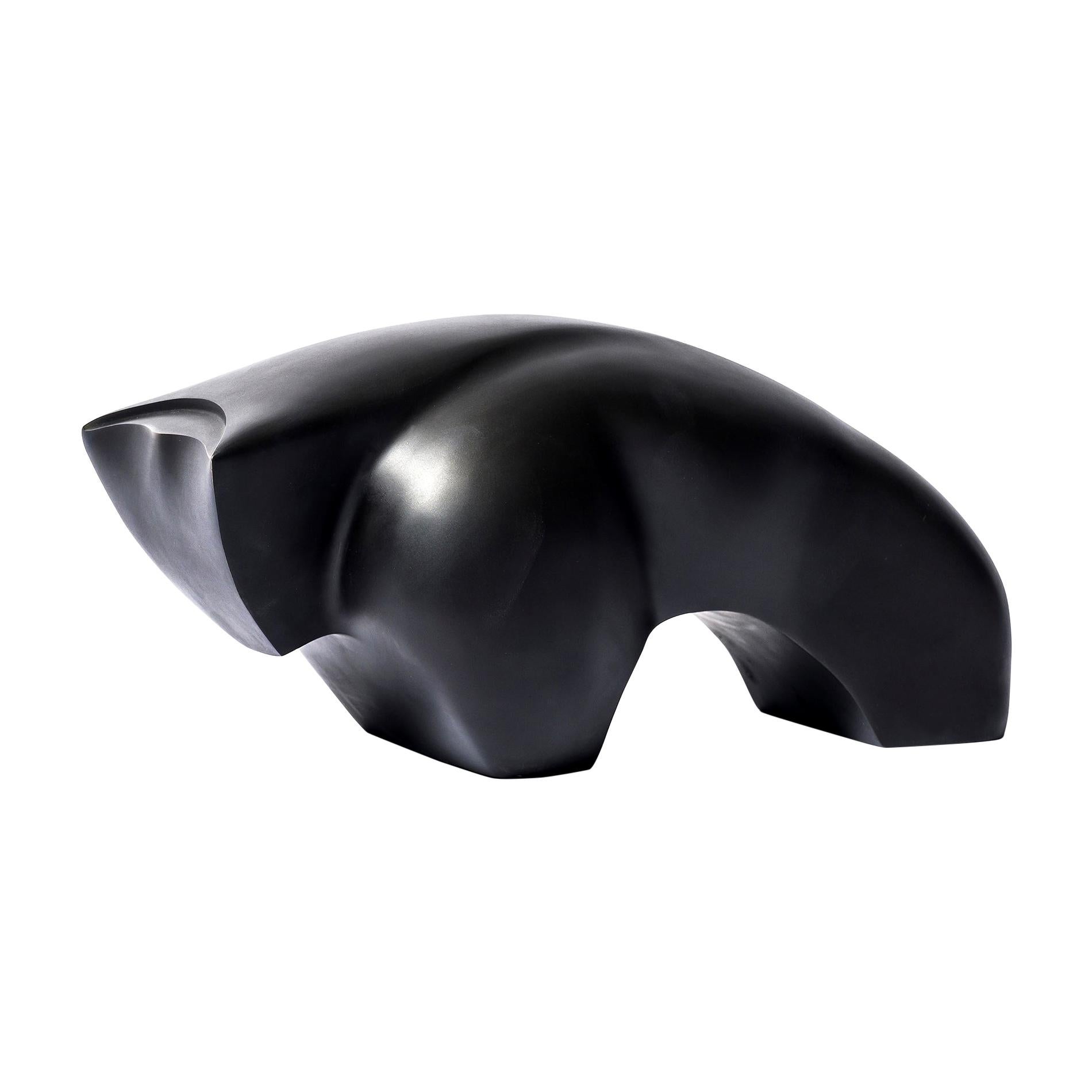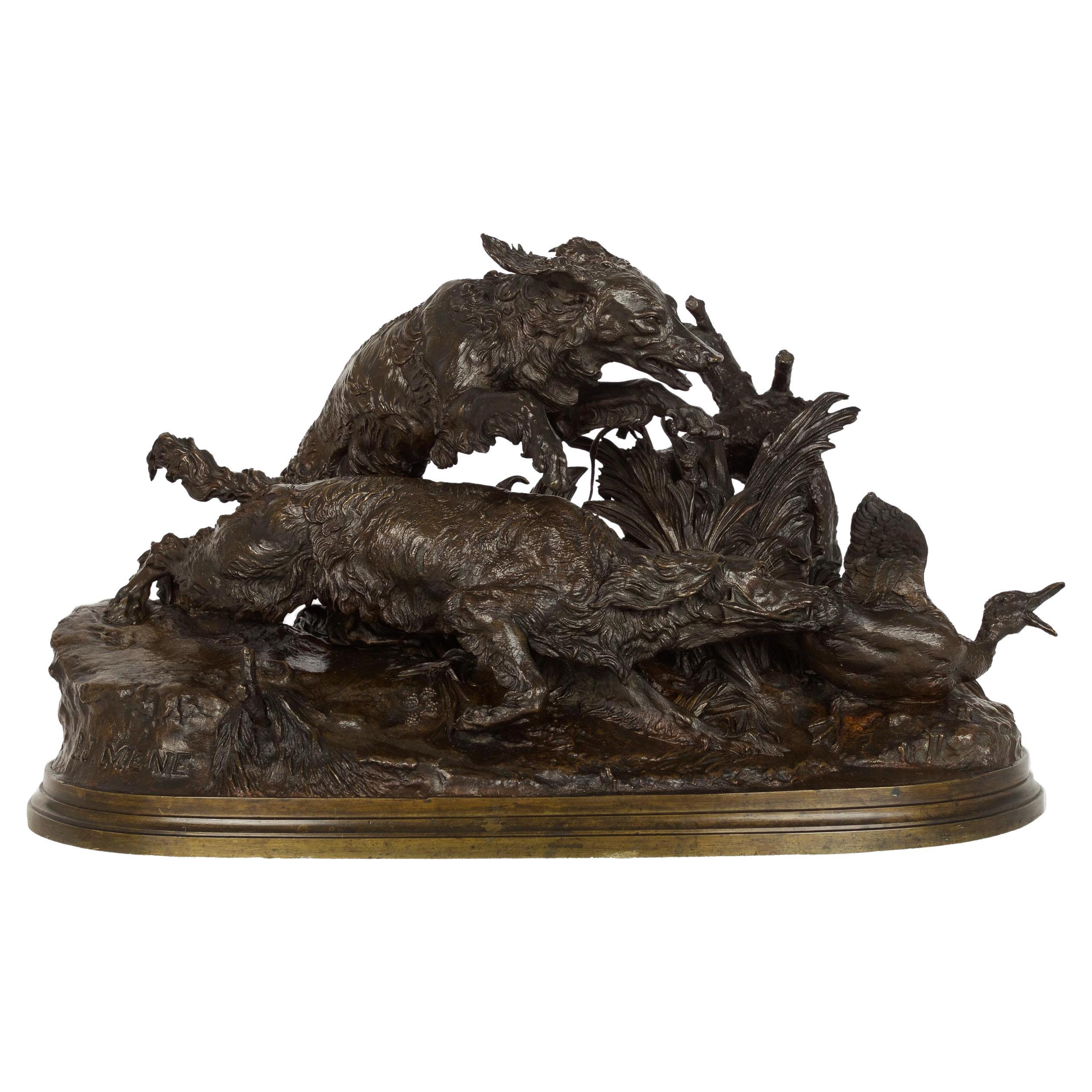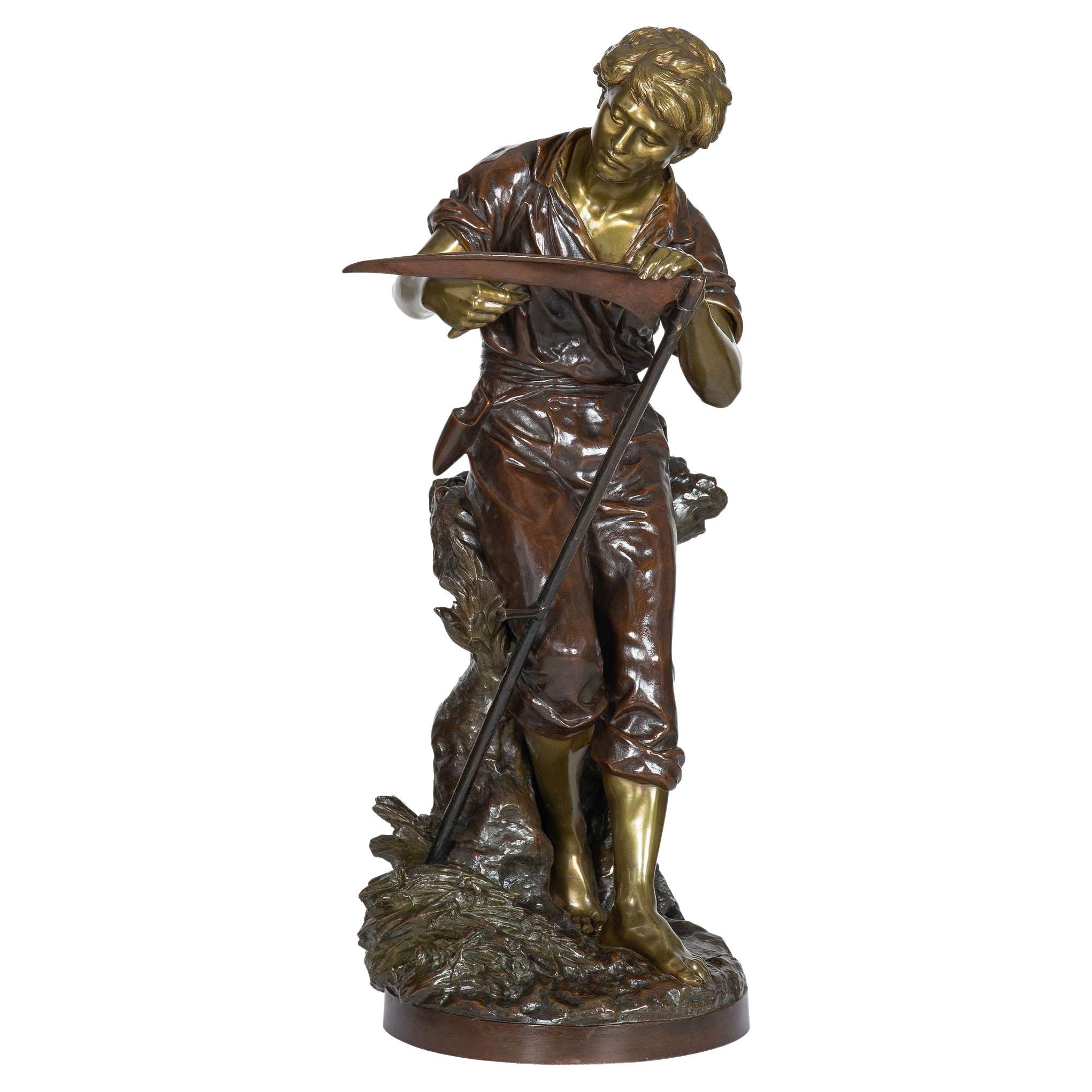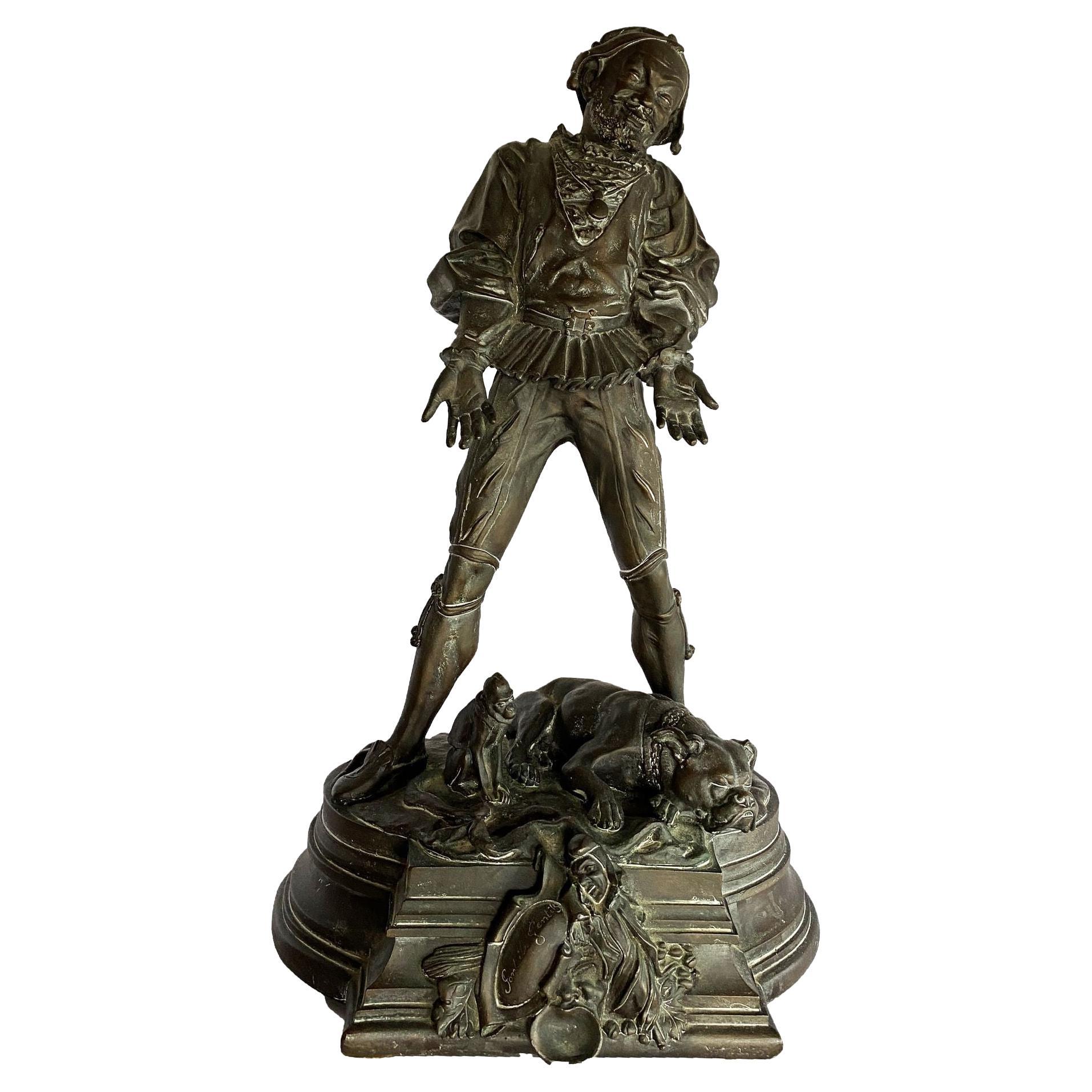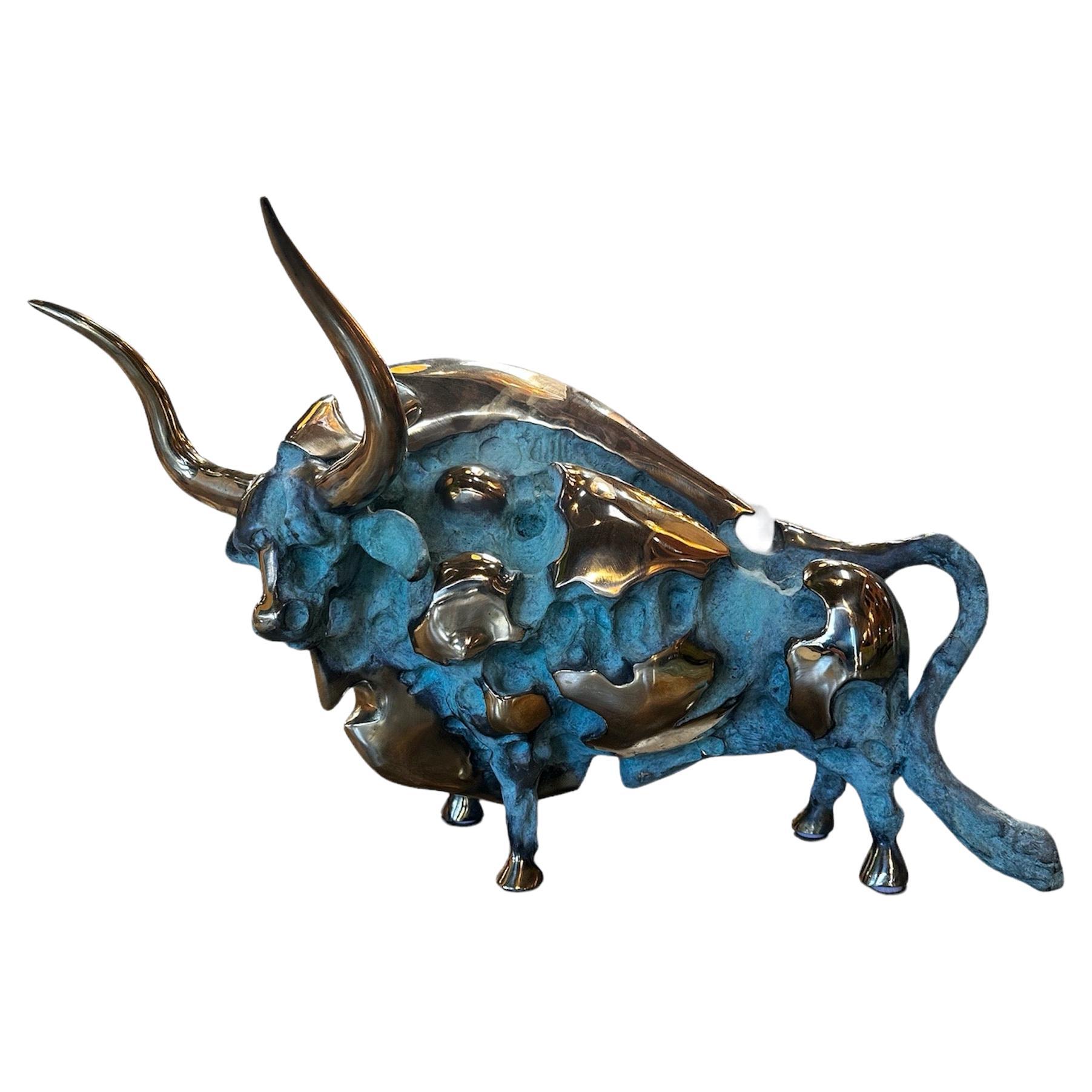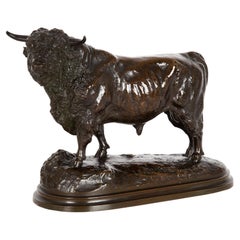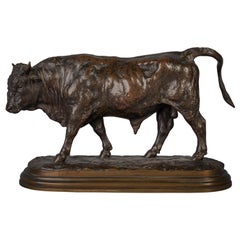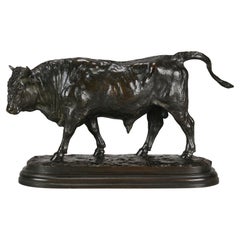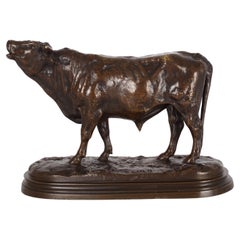
Authentic French Antique Bronze Sculpture"Bellowing Bull"by Rosa Bonheur, c.1860
View Similar Items
Want more images or videos?
Request additional images or videos from the seller
1 of 17
Authentic French Antique Bronze Sculpture"Bellowing Bull"by Rosa Bonheur, c.1860
About the Item
- Creator:Rosa Bonheur (Sculptor),Peyrol Foundry (Maker)
- Dimensions:Height: 6 in (15.24 cm)Width: 8.5 in (21.59 cm)Depth: 4 in (10.16 cm)
- Style:Romantic (Of the Period)
- Materials and Techniques:
- Place of Origin:
- Period:
- Date of Manufacture:1860
- Condition:See condition notes in description text.
- Seller Location:Shippensburg, PA
- Reference Number:Seller: 202IPA12J1stDibs: LU1059027824122
About the Seller
4.9
Recognized Seller
These prestigious sellers are industry leaders and represent the highest echelon for item quality and design.
Platinum Seller
These expertly vetted sellers are 1stDibs' most experienced sellers and are rated highest by our customers.
Established in 2009
1stDibs seller since 2014
469 sales on 1stDibs
Typical response time: 1 hour
More From This SellerView All
- French, Antique Bronze Sculpture of Aberdeen Angus Bull by Isidore BonheurBy Isidore Jules BonheurLocated in Shippensburg, PAISIDORE JULES BONHEUR French, 1827-1901 Taureau Aberdeen-Angus" (Standing Aberdeen-Angus Bull) Patinated sand-cast bronze Signed to base "I. BONHEUR" Item # 211HDB17Z An exquisite and very rare casting of an Aberdeen-Angus bull, an unusual and distinctive breed of cattle from Scotland, this sculpture by Isidore Jules Bonheur is almost without a doubt cast by the foundry of his brother-in-law Hippolyte Peyrol and a rather early model as well in light of the distinctive construction method. In her text on the selection of 46 animal bronzes in the collection of the Georgia Museum of Art, Eleanor Luciano notes regarding this model that "Bonheur is never recorded to have been to Scotland, where he would have seen this unusual breed. Rosa Bonheur painted in Scotland, and its seems likely that Isidore would have drawn the idea for this bull either from one of her sketches or from an agricultural show in France. The animal's rich mane and strong modeling make this one of the most successful." Notable is the very fine surface patination which exhibits a glassy finish with a complex range of colors presenting in the body of the bull, overall being medium brown but augmented with an underlying reddish hue against auburn highlights. The base is signed "I. BONHEUR" in the typical manner. Museum Collections: * National Gallery of Art, Washington DC, acc. no. 2006.128.3 * Georgia Museum of Art, University of Georgia...Category
Antique 19th Century French Romantic Animal Sculptures
MaterialsBronze
- French Bronze Sculpture "Reclining Greyhound" by Christophe Fratin, circa 1860By Christophe Fratin 1Located in Shippensburg, PA"RECLINING GREYHOUND" BY CHRISTOPHE FRATIN (FRENCH, 1801-1864) Signed in naturalistic base "FRATIN", foundry cold-stamped mark along edge "A. DAUBREE EDITEUR"; circa 1860 Item # 102EWL26Q An exquisite sand-cast model of Levrier Couché cast circa 1860, the sculpture is typical of Fratin's vivid texturing and silky finish. It was executed in the foundry of Alfred Daubrée...Category
Antique 19th Century French Romantic Animal Sculptures
MaterialsBronze
- Authentic Atelier Cast Antique Bronze Sculpture of Duck Hunt by Pierre J. MeneLocated in Shippensburg, PAPIERRE JULES MENE French, 1810-1879 "Chasse au Canard" (Duck Hunt) Patinated bronze Signed in naturalistic base "P.J. MENE" Submitted to Salon 1850, a fine atelier cast circa 187...Category
Antique 19th Century French Romantic Animal Sculptures
MaterialsBronze
- French Antique Bronze Sculpture of "Harvester" by Mathurin MoreauBy Mathurin MoreauLocated in Shippensburg, PA"HARVESTER" AFTER A MODEL BY MATHURIN MOREAU (FRENCH, 1822-1912) In a reddish-brown and golden patinated bronze; signed in base "Math. Moreau" Item # 012SKP14W A fine model of a rural young farmer resting against a rocky outcrop to sharpen his scythe, the base of which has been set in the hay collected in a pile beside the rock; the naturalistic base is signed along the back in his typical nearly cursive script "Math. Moreau". It is a complex model and a fine accomplishment for the foundry, the joints seamlessly flowing into one another without any obvious connections. The surface is chiseled with great care, resulting in fine detailing of the toes and fingers to include the wrinkles at each joint and texturing of the nails, crisp eyelids and flawless skin, gorgeous texturing of the garment...Category
Antique Early 1900s French Romantic Figurative Sculptures
MaterialsBronze
- French Antique Bronze Sculpture “Great Dane” by Georges GardetBy George GardetLocated in Shippensburg, PAGEORGES GARDET French, 1863-1939 Recumbent Great Dane Patinated bronze signed in cast "G. GARDET", cold-stamped "865 K" and "FRANCE" Item # 311KOG07P A good casting of Gardet's ...Category
20th Century French Romantic Animal Sculptures
MaterialsBronze
- Antique French Bronze Sculpture "Standing Stag" by Alfred DubucandBy Alfred DubucandLocated in Shippensburg, PAALFRED DUBUCAND French, 1828-1894 "Standing Stag" Medium-brown patinated bronze Signed in naturalistic base "A. Dubucand" Item # 109HPV21P A beautifully textured model of Stan...Category
Antique 19th Century French Romantic Animal Sculptures
MaterialsBronze
You May Also Like
- French Bronze Figure of a Bull, by Rosa BonheurLocated in New York, NYInscribed "Rosa B" and stamped with the "Peyrol" foundry on the base.Category
Antique 1860s Animal Sculptures
MaterialsBronze
- 19th Century Animalier French Bronze Entitled "Taureau Debout" by Rosa BonheurBy Rosa BonheurLocated in London, GB"Taureau Debout" by Rosa Bonheur. An excellent late 19th Century French animalier bronze study of a standing bull with fine hand chased surface that accentuates the muscle definition of the subject, signed Rosa B. ADDITIONAL INFORMATION Measures: Width: 32 cm Height: 18 cm Depth: 11cm Condition: Excellent Original Condition Circa: 1870 Materials: Bronze Book reference: Animals in Bronze by Christopher Payne Page no. 174 DESCRIPTION Bonheur, Rosa (1822-1899) The most popular artist of nineteenth-century France, Rosa Bonheur was also one of the first renowned painters of animals and the first woman awarded the Grand Cross by the French Legion of Honor. A professional artist with a successful career, Bonheur lived in two consecutive committed relationships with women. Born on March 16, 1822 in Bordeaux, Marie Rosalie Bonheur was the oldest of the four children of Raimond Oscar Bonheur (1796-1849) and Sophie Marquis. Bonheur's father was an art teacher who came from a poor family, while her mother, a musician, had descended from a middle-class family and had been her husband's art student. Bonheur's father, who taught drawing and landscape painting, was an ardent member of the utopian Saint Simeon society. The group held idealistic beliefs about the reform of work, property, marriage, and the role of women in society. Most importantly, for the artist's future, the Saint Simeons questioned traditional gender norms and firmly believed in the equality of women. While teaching artistic techniques to his oldest daughter, Raimond Bonheur also encouraged her independence and taught her to consider art as a career. In 1828 Raimond Bonheur joined the Saint Simeons at their retreat outside Paris. Sophie and the children joined him in Paris the following year. Four years later, however, Raimond abandoned his family to live in isolation with his fellow Saint Simeons. Sophie Bonheur died in 1833 at the age of thirty-six. Rosa was only eleven years old when her mother died, but she was aware of the heavy price her mother paid for married life with a man who was more dedicated to his own ideals than to meeting his family's needs. Rosa also saw that her mother's marriage led to poverty and her death from exhaustion. After her mother's death, Bonheur was taken in by the Micas family who resided nearby. Mme Micas and Bonheur's mother had been friends. When Mme Bonheur died, the Micas family paid Raimond Bonheur's debts and cared for Rosa. Their daughther, Nathalie, who would later become an amateur inventor and unschooled veterinarian, and Rosa became enamored with each other. When Rosa Bonheur began her career as a professional artist, she had already been trained by her father who had allowed her to study in all male classes. Rosa also learned by sketching masterworks at the Louvre from the age of fourteen, and later, by studying with Léon Cogniet. From the very beginning, Bonheur's favorite subject was animals. She learned their anatomy completely by dissecting them in local slaughterhouses. She also visited the horse market two times a week. Study of animals by direct observation led to the formation of the realist style in which Bonheur worked. It was for such work that Bonheur obtained written permission from the French government to wear men's slacks. Her working attire also consisted of a loose smock and heavy boots that protected her feet from the dangerous environment in which she painted. The style of dress that the artist adopted for work and home may well have been influenced by her father's attire, which was based on St. Simeonian clothing experiments. Bonheur also cropped her hair, perhaps to facilitate her work. She did, however, always wear dresses for social occasions because she knew that appropriate dress would further her career. Bonheur earned a successful living as a painter of animals. She exhibited at the annual Paris Salon regularly from the age of nineteen in 1841 through 1853, when she was thirty-one. She won the salon's gold medal at the age of twenty-six in 1848 and was commissioned by the French government to paint Plowing on the Nivernais in 1849. In the same year Bonheur and her sister Juliette became directors of l'École gratuite de dessin pour les jeunes filles, a post their father had once held. Bonheur completed her most renowned work, The Horse Fair, in 1855. The successful representation of percherons (a breed native to Normandy) was purchased by Ernest Gambart, a London art dealer whose gallery specialized in work by French artists. He exhibited The Horse Fair in London where Bonheur visited with Nathalie. Queen Victoria requested a private viewing of the painting at Windsor Castle. It would later be purchased in 1887 by Cornelius Vanderbilt and donated to the new Metropolitan Museum of Art in New York City. Bonheur's trip to England allowed her to meet Charles Eastlake, then President of the Royal Academy, John Ruskin, the English writer and critic, and Edwin Landseer, the British animalier. She also toured the English and Scottish countrysides and executed some paintings based on her observations of new breeds of animals found there. Gambart made engravings of Bonheur's work, including The Horse Fair, and sold them in England, Europe, and the United States. Bonheur became one of the most renowned painters of the time. Little girls, such as Anna Klumpke in the United States, even had dolls in her likeness, much as American girls played with Shirley Temple dolls...Category
Antique 19th Century French Art Nouveau Animal Sculptures
MaterialsBronze
- Bull Bronze SculptureLocated in Paris, FRSculpture bull bronze all in patinated solid bronze, lost wax bronze technic. Also available in polished bronze on request, including an up-charged.Category
21st Century and Contemporary Italian Animal Sculptures
MaterialsBronze
$4,287 Sale Price / item20% Off - Bull Polished Bronze SculptureLocated in Paris, FRSculpture bull polished bronze all in patinated solid bronze, lost wax bronze technique.Category
21st Century and Contemporary Belgian Animal Sculptures
MaterialsBronze
$5,687 / item - Bronze Sculpture by Karel Hladik Depicting a BullBy Karel HladíkLocated in Saint-Ouen, FRKAREL HLADIK (1912-1967) Decorative plaque depicting a bull Bronze sculpture Signed and titled Karel Hladik (27 June, 1912 - le 27 April, 1967) is a Czech sculptor and uni...Category
20th Century Animal Sculptures
MaterialsBronze
- 1960s Bronze Bull Sculpture by Venancio BlancoBy Venancio BlancoLocated in Marbella, ES1960s bronze bull sculpture by Spanish Sculptor Venancio Blanco, who died in 2018 and a foundation that bears his name has been set up to promote his work.Category
Mid-20th Century Spanish Animal Sculptures
MaterialsMarble, Bronze
Recently Viewed
View AllMore Ways To Browse
Bonheur Bronze
Antique French Wax Seal
Bronze Sculpture By Rosa
Antique Wax Seals Gold
Bonheur Rosa
Antique Seal Stamps
Bronze Wax Seal
Wax Seal Stamp
Antique Wax Seal Stamp
Antique Wax Seal Stamp Seals
Wax Seal Stamp Antique
Antique Wax Seal Stamp Stamps And Seals
Antique Wax Seal Stamps And Seals
Antique Gold Bonheur
Authentic Models Catalogue
French Gold Wax Seal
H C Payne
Rosa Bonheur Bronze

